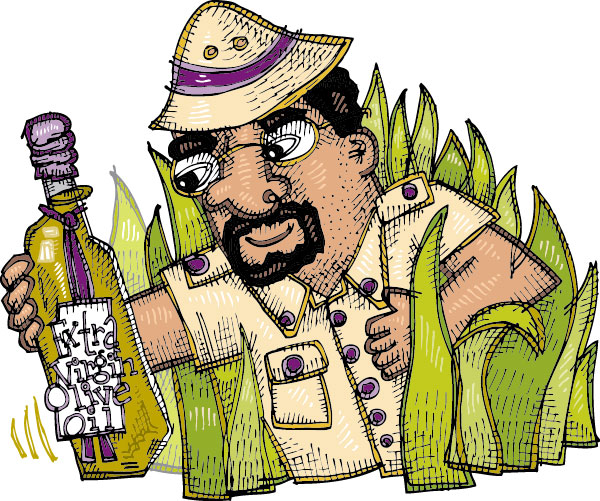“Extra virgin” is a legal term used to categorize olive oil. It’s like the USDA ratings for beef: Prime, Choice, and Select. For olive oil, the standards are set by the IOC, or International Olive Council, an organization set up by the UN to coordinate and promote olive and olive oil production.
Just like the USDA beef ratings, the IOC specifies a hierarchy for olive oils. From highest to lowest quality, the rankings are: extra virgin olive oil, virgin olive oil, and ordinary olive oil (on labels, it’s usually just called “Olive Oil,” or sometimes “Pure Olive Oil”). There are additional lower rankings of olive oils that aren’t for consumption, just like how beef that ranks lower than “Select” still gets used for other products, like dog food.
There’s a three part test for extra virginity: how it’s made, its chemical composition, and how it tastes.
First, extra virgin olive oil, virgin olive oil, and ordinary olive oil must all be made only from olives, and processed only by mechanical means (which is to say, no chemicals can be used). These might seem like no-brainers, but since ancient Roman and Greek times and continuing to today, conniving oil salesmen cut good olive oil with cheaper oils, like sunflower oil or heavily chemically refined olive oil, to boost their profit margins.
Secondly, extra virgin olive oil must have less than 0.8% oleic acid, which, counterintuitively, is the name for a type of fat, not an acid like vinegar. Oleic acid occurs naturally in olives and many other vegetable and animal fats. As olive oil oxidizes—which is a technical way of saying, as olive oil goes rancid—the amount of oleic acid increases. In other words, an extra virgin olive oil must be less than 0.8% rancid. Virgin olive oil must have between 0.8-2% oleic acid. Ordinary olive oil is between 2-3.3% oleic acid.
What makes for more oleic acid? One big factor is how the olives are handled. Like apples, olives will bruise if they get bumped around. And just like how an apple that falls to the floor is probably still pretty good if you eat it immediately but develops a big, mushy brown spot if you let it sit for a few days, a bruised olive gets worse the longer it sits around, too. To produce olive oils with low oleic acid (and also ones that taste great), it’s best to handle the olives gently and get them to the mill as quickly as possible. After pressing, the oil should be stored away from light and oxygen, both of which will oxidize it (and thus create more oleic acid) over time.
Third, extra virgin olive oil must meet certain flavor standards. First, it should taste “fruity,” which, as the IOC uses it, means that it should taste like olives. The IOC also considers bitterness and pepperiness to be positive flavor attributes for oils. Secondly, an extra virgin oil must not have any flavor defects. In particular, it should not taste muddy, winey, or rancid, each of which indicates poor handling of the olives. Virgin and ordinary olive oils are also supposed to taste fruity, but they’re allowed to have some flavor defects.
Does “extra virgin” mean the oil is good?
In a word, no. It does mean in most cases it should be better than oils labeled as virgin or just plain olive oil, but there’s an enormous range in quality of oils labeled as “extra virgin.” What’s more, thanks to the alleged widespread adulteration and corruption in the big olive oil industry, a vast proportion of what’s labeled as “extra virgin” doesn’t truly meet the IOC’s standards. For a deeper look into olive oil fraud, check out Tom Mueller’s fascinating book, Extra Virginity.
So how do you buy a good oil? Oils from smaller producers—especially those grown and pressed on a single estate (which is the case for practically every oil we sell)—are much less likely to be tampered with. But the best advice I can give you is to taste it. If an oil tastes good to you, and gives good flavors to the foods you eat with it, then it’s good.

